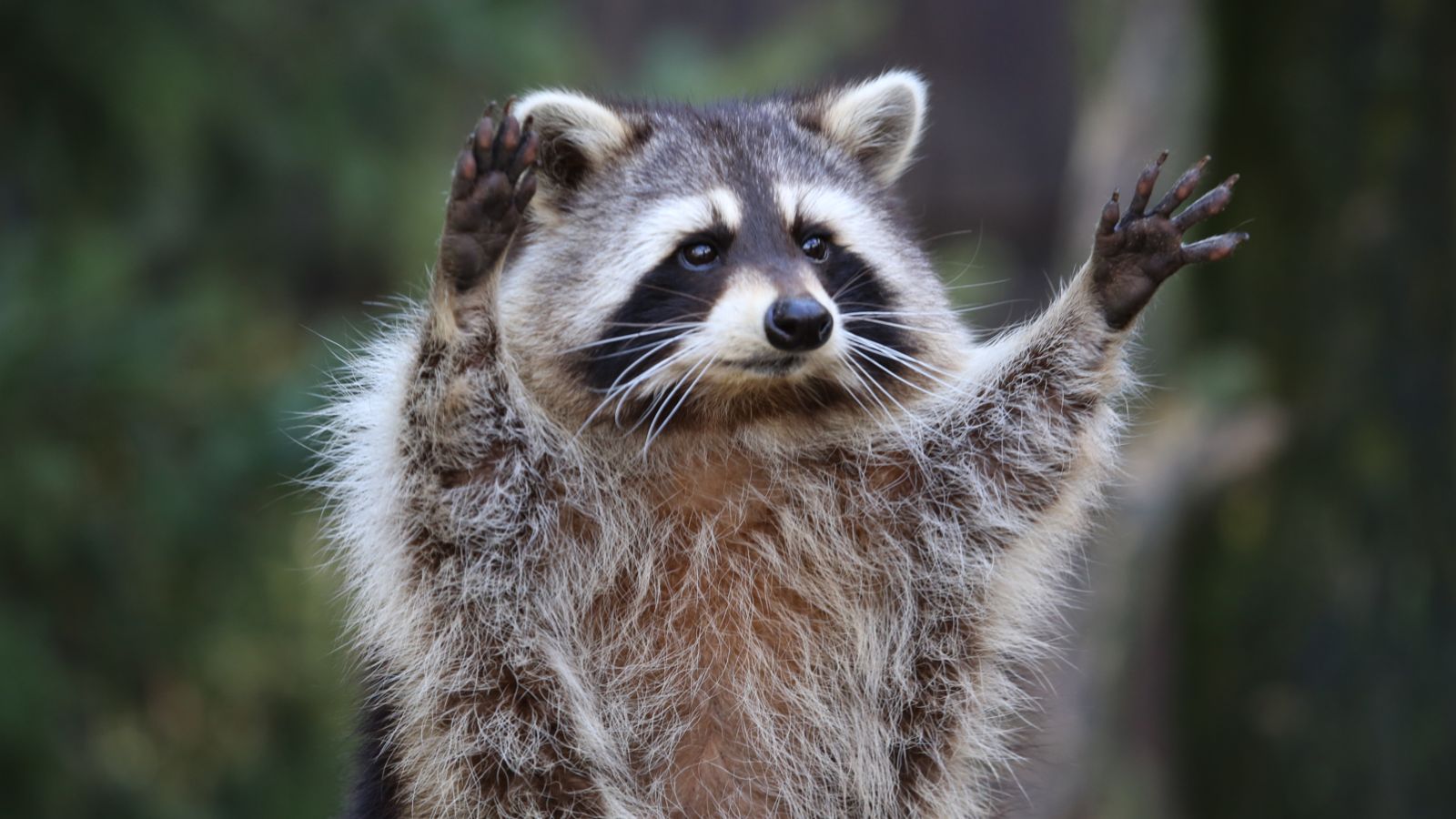Raccoons are adaptable and intelligent animals that live in wild and urban environments nationwide. While many view them as irritating pests, they are an interesting species with unique characteristics. Here are 17 facts about raccoons everyone should know.
Unique Appearance of Raccoons

A-Z Animals explains that their distinctive “mask functions much like a football player’s glare-reducing eye black.” The black fur allows them to absorb light, making it easier to see clearly in bright light and reducing glare at night, improving their nocturnal vision.
Omnivorous Diet

Raccoons are omnivores with a varied diet, including fruits, nuts, insects, small mammals, and birds in the wild. They are also known for consuming human food waste in urban areas. Their eating habits change with the seasons; they prepare for the winter by eating more in the fall.
Affinity for Water

Although they are not aquatic animals, raccoons are excellent swimmers and often live near water sources in the wild. Water bodies are crucial for a raccoon’s diet, providing them with fish, snails, and worms.
Social Structure

Raccoons are mostly solitary animals, but females will live in communal groups, especially when raising young. Males are solitary, with larger territories that may overlap with several females, and they tend to avoid other males.
Life Cycle

Raccoons breed in the late winter and have one litter annually. After a 60-day gestation period, they usually give birth to two to five kits in the early spring. The kits are born deaf and blind and are completely dependent on their mother for the first few months.
The Sounds of Raccoons

Raccoons can make over 200 sounds, with hisses, whistles, screams, and growls, each serving a unique communication purpose. They can purr like cats and bark like dogs when they are excited or stressed. Mothers and kits also have a unique communication system, with kits making chirping sounds to call their mothers.
Nocturnal

Raccoons are primarily nocturnal, with heightened senses of touch and hearing that help them navigate and forage in the dark. However, the Toronto Wildlife Centre notes that they can also be active during the day for a variety of reasons, including when there is an available food source and if the area has competition from other nocturnal animals.
Raccoon Tracks

Raccoon tracks are distinctive due to their front paws resembling tiny human hands. Their tracks can often be found near water bodies and garbage sources, with a diameter of two to three inches across.
Predators and Threats

Bears, bobcats, owls, coyotes, wolves, and snakes prey on raccoons in wild areas in North America. In urban settings, cars and human activities pose the most significant threats to their survival.
Raccoons and Rabies

Raccoons are infamous for being one of the primary wild carriers of rabies in North America, accounting for 35% of rabid animals. They usually die within 1–3 days of becoming infectious. Many Americans assume raccoons active in the daytime are rabid, but most are looking for food.
Urban Adapters

Raccoons have successfully adapted to urban environments in North America, and urban raccoons tend to be larger and have a higher survival rate than their rural counterparts due to the wide availability of food sources. National Geographic argues that raccoons “possess many qualities suited to city life, from their nocturnal nature, which helps them avoid run-ins with people, to their wide-ranging diet.”
Behavior Throughout the Year

Raccoons don’t hibernate in the winter, but they can enter torpor, a dormancy state where they slow their metabolism and sleep in their dens. Torpor only lasts a few weeks, unlike hibernation. In spring and summer, rearing young takes precedence for females.
Dens

Raccoons are known to be adaptable when choosing their dens, which can be in tree hollows, abandoned burrows, or attics and chimneys in urban areas. They also usually have multiple den sites at a time.
Intelligence and Problem-Solving Skills

According to Britannica, “raccoons are intelligent and inquisitive animals.” They possess remarkable problem-solving abilities and can apply past experiences to help them adapt to new situations and challenges.
Raccoons and Human Interaction

Raccoons can be a nuisance in urban areas. They set up dens in houses and pull down garbage cans when searching for food. Buying a lock for garbage can lids, placing heavy weights on them, and storing them in garages or sheds can help deter raccoons.
Conservation and Control: Balancing Raccoon Populations

The IUCN currently considers the North American raccoon to be a least-concern species. Urban wildlife management strategies in the U.S. include sterilization programs and habitat modification to limit their spread.
Raccoons in Pop Culture

Raccoons appear in the mythology of Native Americans and are the subject of many folk tales nationwide. They’re often depicted as cunning but endearing characters, and in the past decade, Rocket Raccoon has been a prominent character in Guardians of the Galaxy.
Read More: 17 Religious Facts People Get Wrong All the Time

Religious beliefs and practices are often misunderstood, leading to common misconceptions. Some are just too general, others are downright out there. So, we’ll be correcting 17 widely circulated ‘facts’ about world religions.
17 Religious Facts People Get Wrong All the Time
Why People Aren’t Religious Anymore: 15 Simple Reasons

As society evolves, so does our approach to spirituality. This article looks at the subtle yet profound shift from traditional religious adherence to a more personal, evidence-based belief system.
Why People Aren’t Religious Anymore: 15 Simple Reasons
17 American Attractions That Not Even Americans Want to Visit

The United States of America—land of the free, home of the brave, and the location of some of the most ‘unique’ tourist attractions you’ll ever lay eyes on.
Get ready to chuckle, scratch your head, and maybe even facepalm as we look at 17 American attractions that not even Americans think are worth visiting.
17 American Attractions That Not Even Americans Want to Visit
20 Things We Did When We Were Young That We Regret Now

It’s easy to say hindsight is 20/20, but what advice would you really give your younger self? Here are 20 things that most people did when they were young that they regret today.
20 Things We Did When We Were Young That We Regret Now
17 Things That Used to Be Highly Respected But Isn’t Anymore

Many things in the world used to be well-respected before turning into complete jokes for various reasons. An internet survey recently asked people, “What is something that was once highly respected but is now a complete joke?” Here are the top 20 answers:
17 Things That Used to Be Highly Respected But Isn’t Anymore

